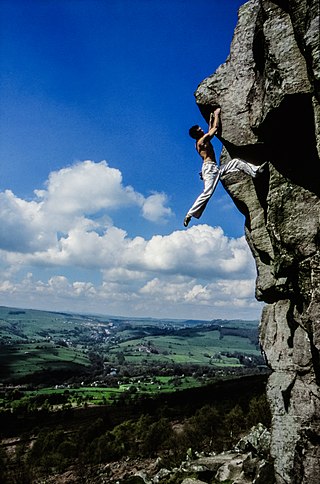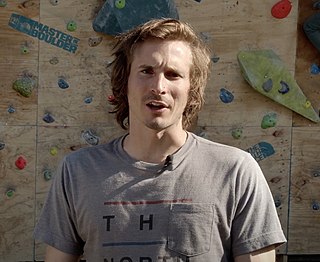
Bouldering is a form of free climbing that is performed on small rock formations or artificial rock walls without the use of ropes or harnesses. While bouldering can be done without any equipment, most climbers use climbing shoes to help secure footholds, chalk to keep their hands dry and to provide a firmer grip, and bouldering mats to prevent injuries from falls. Unlike free solo climbing, which is also performed without ropes, bouldering problems are usually less than six metres (20 ft) tall. Traverses, which are a form of boulder problem, require the climber to climb horizontally from one end to another. Artificial climbing walls allow boulderers to climb indoors in areas without natural boulders. In addition, bouldering competitions take place in both indoor and outdoor settings.

David Ethan Graham is an American professional rock climber. Professing to enjoy bouldering the most, he is one of the elite sport climbers and boulderers of his generation. Graham repeats classic routes or boulder problems as well as performing cutting-edge first ascents. He is known for climbing in 2005 an 8C (V15) graded boulder problem called The Story of Two Worlds, in Cresciano, Switzerland). He is also known for his stance against grade inflation and for his strong anti-chipping ethic. He writes an ongoing blog for the website of Climbing Magazine.
Fred Rouhling is a French rock climber and boulderer, noted for creating and repeating some of the earliest grade 9a (5.14d) sport climbing routes in the world, including Hugh in 1993, the first-ever French 9a (5.14d) sport route. Rouhling is also known for the controversy from his proposed grading of 9b (5.15b) for his 1995 route Akira, which would have made it the world's first-ever 9b-graded sport route; 25 years later, it was graded at 9a (5.14d).

Jerry Moffatt, is a British rock climber and climbing author who is widely considered as being the best British rock climber from the early-1980s to the early-1990s, and was arguably the best rock climber in the world in the mid-1980s, and an important climber in the history of the sport.

John Gill is an American mathematician who has achieved recognition for his rock-climbing. He is widely considered to be the father of American bouldering.
The Fly is a short 25-foot (7.6 m) schist sport climbing or highball bouldering route in the Rumney Rocks climbing area, New Hampshire, USA, at the Waimea Cliff. The Fly was bolted by Mark Sprague in 1995 as an open project but did not see a first free ascent until David Graham, an 18-year-old American climber from Maine, climbed it in April 2000, who graded it 5.14d (9a) or V14 (8B+). It was quickly repeated by his climbing partner, Luke Parady. At the time, these ascents were milestones for climbing in North America.
Lisa Rands is an American rock climber. She is known for her bouldering for which in 2002, she became the first American female to win IFSC World Cup bouldering competitions, and topped the IFSC world boulder rankings in 2002. Rands was the first American female to climb boulders of grade V11 (8A), and V12 (8A+), and was the second-ever female in history to climb a 7C+/8A boulder. As well as making first female ascents (FFAs) of boulders such as The Mandala V12 (8A+), Rands was the first female in history to do an E8-graded traditional climbing route, The End of the Affair.

The Mandala is a 6-metre (20 ft) high granite bouldering route in the Buttermilks, a popular bouldering area near Bishop, California. Considered a "next generation" problem in the 1970s, the route was first solved by American climber Chris Sharma in February 2000. It is one of the most widely known boulder problems in the world and is graded at V12 (8A+), and the sit start variation is graded at V14 (8B+).

Pat Ament is an American rock climber, filmmaker, musician, and artist who lives in Fruita, Colorado. Noted for first ascents in the 1960s and 1970s, he is the author of many articles and books.

In the history of rock climbing, the three main sub-disciplines—bouldering, single-pitch climbing, and big wall climbing—can trace their origins to late 19th-century Europe. Bouldering started in Fontainebleau, and was advanced by Pierre Allain in the 1930s, and John Gill in the 1950s. Big wall climbing started in the Dolomites, and was spread across the Alps in the 1930s by climbers such as Emilio Comici and Riccardo Cassin, and in the 1950s by Walter Bonatti, before reaching Yosemite where it was led in the 1950s to 1970s by climbers such as Royal Robbins. Single-pitch climbing started pre-1900 in both the Lake District and in Saxony, and by the late-1970s had spread widely with climbers such as Ron Fawcett (Britain), Bernd Arnold (Germany), Patrick Berhault (France), Ron Kauk and John Bachar (USA).

The Wheel of Life is a 21-metre (69 ft) long sandstone bouldering route on the roof of the Hollow Mountain Cave in the Grampians of Australia. When first solved, it was graded at 8C+ (V16), one of the world's first-ever boulder routes at that grade. With subsequent repeats, it was graded at 8C (V15), and some consider it to really be a sport climbing traverse route, at the sport grade of 9a (5.14d).
Paul David Robinson is an American professional rock climber who specializes in bouldering. He has established and repeated several bouldering problems at the V15 difficulty rating, in such areas as Hueco Tanks, the Buttermilks, and Magic Wood. In 2007, Robinson became the second climber in history to successfully climb a V13 boulder problem in one attempt.
Darlene Thomasina Pidgeon is a Canadian rock climber known for being one of the world's strongest female boulderers in the early 2000s and 2010s, was for a time the strongest female Canadian boulderer, and was the first Canadian female to climb the grades of V10, V11, and V12. She is often featured in Gripped Magazine and contributes to The Collective. She has also been featured in several international magazines and websites and her image has been used in advertising, magazine galleries, and magazine covers.

Alex Puccio is a professional climber specializing in bouldering. She competes in climbing competitions and split her time between climbing outdoor and indoor. She finished third overall in the 2011 and 2013 World Cup bouldering competition, second overall in the 2014 Climbing World Championship bouldering competition, and has won the American Bouldering Series eleven times.

Ashima Shiraishi is an American rock climber. Shiraishi started climbing at the age of six at Rat Rock in Central Park, joining her father. Only a few years later, she quickly established herself as one of the top boulderers and sport climbers in the world. Her numerous accolades include first-place finishes in international competitions, and multiple first female and youngest ascents. Shiraishi is featured in several short documentary-style films, and is the subject of the documentary short "Return to the Red" (2012).

Daniel Woods is an American professional rock climber who specializes in bouldering, and who is considered one of the most important climbers in the history of bouldering. Woods has climbed over thirty boulder problems graded at or above 8C (V15). He has also won several competition bouldering events, such as the U.S. National Bouldering Championship and some international events. In March 2021, Woods achieved the first ascent of a low start to Sleepwalker V16 (8C+) which he named Return of the Sleepwalker and proposed the grade 9A (V17), only the second-ever route in history at that grade.
Tomoko Ogawa is a Japanese boulderer. In 2012, she sent Catharsis, a boulder route in Shiobara established by Dai Koyamada, and confirmed by Daniel Woods, to become the first-ever woman to climb a 8B+ (V14) route. Since then, only three other women -- Ashima Shiraishi, Shauna Coxsey, and Alex Puccio—have sent problems of that level. Ogawa began climbing in 2000, at age 22. Her other notable ascents of boulders include Caramba 8A+ (V12), Mutante 8A+ (V12), Akugeki 8A/8A+ , Atomic Playboy 8A (V11), Hatchling 8A (V11), and No Late Tenders 8A (V11).
Angela Payne is an American rock climber specializing in bouldering, who won a clean sweep of the 2003-2004 US American Bouldering Series, and who in 2010, became the first-ever female in history to climb an 8B (V13) boulder.

Alexandra Johnson is an American rock climber who has made numerous first female ascents, including Clear Blue Skies V12 (8A+) in Colorado, and Book of Nightmares V12 (8A+) and Lethal Design V12 (8A+) in Red Rocks. Her highest rated send, as of 2022, was “The Swarm” V14 (8B+) in Bishop. In 2009, she won the overall American Bouldering Series, and has twice won individual stages in the annual Bouldering World Cup series.












